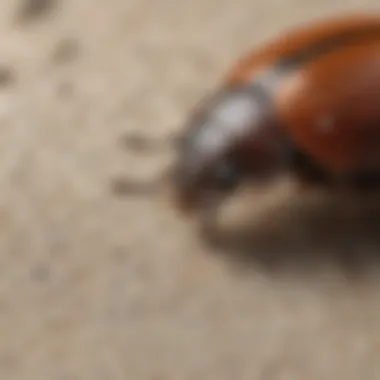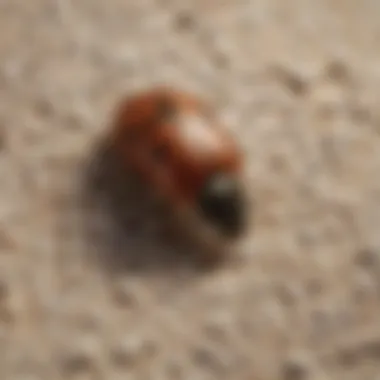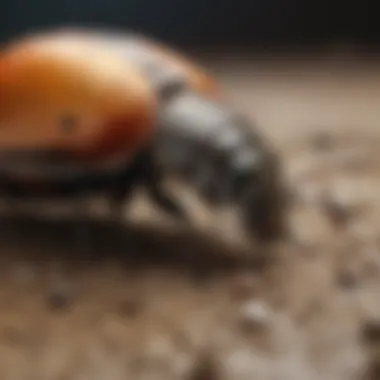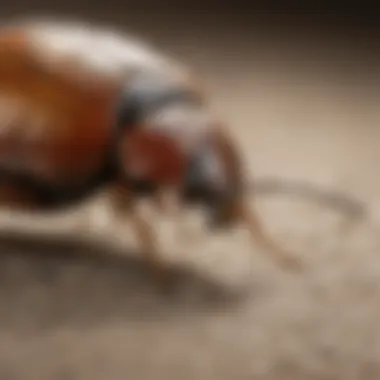Comprehensive Guide to Eliminating Carpet Beetles


Intro
Carpet beetles can cause significant damage to fabrics in your home. Understanding their biology, signs of infestation, and effective methods for control is essential. This guide presents a comprehensive approach to identifying, preventing, and treating carpet beetle issues. Homeowners must develop a systematic strategy to regain control of their living spaces.
Pest Identification
Detailed descriptions of common pests
Carpet beetles belong to the family Dermestidae. The most common species are the varied carpet beetle (Anthrenus verbasci), the black carpet beetle (Attagenus unicolor), and the furniture carpet beetle (Anthrenus flavipes).
- Varied carpet beetle: These beetles are oval-shaped, measuring about 1/8 to 1/4 inch in length. Their coloration ranges from black to brown with patterns of white, yellow, and orange.
- Black carpet beetle: This species is shiny and solid black, similar in size to the varied carpet beetle.
- Furniture carpet beetle: Smaller and often found on upholstered furniture, it is a mix of black and brown with a somewhat fuzzy appearance.
Signs and symptoms of infestations
Identifying carpet beetles early can save homeowners a substantial amount of repair costs. Some common signs include:
- Molted skins: Carpet beetles shed their exoskeletons as they grow, leaving behind small, brown skins.
- Larvae: The immature form is often found in hidden places like dark corners or under furniture.
- Damage to fabrics: You may notice holes or frayed edges on clothing, rugs, or upholstery.
"Carpet beetles prefer natural fibers, making them a danger to wool, silk, and cotton materials."
Be vigilant when cleaning as it can reveal infestations before they spread.
Prevention Strategies
Home maintenance tips for pest prevention
Preventing carpet beetles begins with regular home maintenance. Here are some strategies:
- Regular cleaning: Vacuum frequently, especially in corners and under furniture. Be certain to dispose of the vacuum bag or empty the canister outside.
- Storage: Keep clothes and textiles in sealed containers. This limits the beetles’ access to potential food sources.
- Natural light: Carpet beetles prefer dark environments. Having natural light, as much as possible, can deter them from entering certain areas.
Natural deterrents and barriers
In addition to cleaning, certain natural products can help keep carpet beetles at bay:
- Essential oils: A mix of peppermint and clove oil can act as a repellent. Dilute a few drops in water and spray in areas where you suspect infestations.
- Diatomaceous earth: This natural powder can be sprinkled around entry points. It is safe for humans yet deadly to insects.
Treatment Options
Overview of chemical vs. natural treatments
If an infestation occurs, homeowners can choose between chemical or natural treatments. Chemical solutions may offer rapid results, but natural treatments can be safer for families and pets.
Step-by-step guides for DIY treatments
Here are some DIY treatment options:
- Vacuuming: Start by vacuuming infested areas thoroughly. Dispose of vacuum contents immediately after.
- Hot water wash: Wash any washable fabrics in hot water. This helps kill larvae and eggs.
- Spray natural solutions: After cleaning, apply your prepared essential oil mixture around potential entryways and infested areas.
- Use traps: Beetle traps, available at many stores, can help in monitoring infestations and reducing beetle populations.
By carefully identifying and taking proactive steps, homeowners can effectively eliminate carpet beetles from their spaces.
Understanding Carpet Beetles
Understanding carpet beetles is essential for homeowners. Identifying these pests quickly helps to minimize damage. Recognizing their characteristics, behaviors, and life cycle can crucially inform your approach to prevention and treatment. Knowing these aspects makes your efforts in pest control more effective.
Identification of Carpet Beetles
Physical Characteristics
Carpet beetles are small insects, typically measuring 1/8 to 1/4 of an inch in length. Their actual identification is based on color patterns. The common carpet beetle, for example, has a mix of black, brown, and yellow scales. This distinct coloration not only helps in their identification but also points to their habitat preferences. These beetles can blend in with the environment, making them difficult to detect initially. Their hard exoskeleton offers protection but can be a limitation for manual removal in the early infestation stages.
Behavioral Traits
Carpet beetles are primarily attracted to organic materials like wool, silk, and feathers. Their feeding behavior is destructive, as they consume fibers and cause noticeable damage to fabrics. Another aspect of their behavior is that they are usually active during the day but can be found hiding in dark, undisturbed areas at night. Recognizing this pattern enables the homeowner to focus inspections on the right locations, ultimately aiding in pest control efforts.
Life Cycle of Carpet Beetles
Egg Stage
The egg stage is crucial in the carpet beetle life cycle. Females can lay anywhere from 30 to 100 eggs. These tiny eggs are oval and hard to see, often placed in areas where larvae can easily find organic materials. Understanding this stage can help homeowners in targeting areas for inspection and cleaning where eggs may be present.
LARVAL Stage
The larval stage is perhaps the most destructive phase of carpet beetles. The larvae are small, creamy-white with brown bristles. They feed voraciously on fabrics, leading to visible damage to clothing and upholstery. Being aware that this stage lasts several months informs the need for thorough cleaning practices, as larvae contribute significantly to infestations.


Adult Stage
Adult carpet beetles are not as destructive as larvae, but they can still pose issues. They tend to feed on pollen and nectar from flowers. While their damage is minimal, they can continue the life cycle, leading to new infestations if not managed properly. Understanding that adult beetles can reproduce quickly forces homeowners to take immediate action upon discovery.
Signs of Infestation
Identifying the signs of carpet beetles is a crucial aspect of pest control. Timely recognition can prevent significant damage to home textiles and furnishings. Recognizing these signs allows homeowners to take action swiftly. Carpet beetles can cause serious harm, so it is beneficial to understand the common indicators of an infestation.
Common Indicators of Carpet Beetles
Visible Damage to Fabrics
Visible damage to fabrics is often the first clear sign of a carpet beetle infestation. Homeowners may notice holes or irregular shapes in carpets, rugs, or clothing. This damage is typically caused by the larvae, which feed on natural fibers like wool, silk, and cotton. The presence of such damage acts as a warning signal to assess the outbreak more closely.
The key characteristic of this damage is its irregularity, often resembling small bites. It is especially concerning because, without intervention, the damage can grow rapidly, potentially leading to costly replacements. The unique feature of this damage is that it often appears in less visible areas, such as under furniture, making it easy to overlook at first. This can delay necessary action and aggravate the situation.
Presence of Shed Skin
The presence of shed skin can also indicate a carpet beetle problem. The larvae repeatedly shed their exoskeletons during their growth cycle. Finding these skins in your home can mean that an infestation is active. It highlights a successful lifecycle progression, indicating that larvae are feeding and maturing.
A key characteristic of shed skin is that it resembles small, empty shells. They are typically found in areas where beetles are active, such as corners or near food sources. This feature is useful as it gives homeowners a specific target area for inspection. It is also often less noticeable than fabric damage, which can lead to underestimating the problem.
Adult and Larval Sightings
The actual sighting of adult or larval carpet beetles is a definitive sign of an infestation. Adults are small, oval-shaped beetles, while larvae are elongated and have a more fuzzy appearance. Spotting these insects can alarm many homeowners, but it is vital for recognizing that an issue exists.
The distinctive aspect of sightings is that they provide the most direct evidence of beetles in the home. Identifying them correctly can help differentiate between carpet beetles and similar pests. However, relying solely on them can lead to underestimating the infestation, as larvae may be less conspicuous. Regular inspections are necessary for thorough evaluation.
Differentiating from Other Pests
Similar Looking Insects
Carpet beetles can be mistaken for other household insects, such as black carpet beetles or certain types of moths. Understanding the similarities and differences is crucial in pinpointing the right intervention strategy. This confusion can impede effective pest management, often leading to the use of inappropriate treatment methods.
A key characteristic of similar-looking insects is their color and shape. For instance, many clothes moths share a similar size and habitat with carpet beetles. Knowing about such insects is beneficial, as it prepares homeowners for accurate identification. Knowing their unique features, like the distinct bristle-like appearance of carpet beetle larvae, can help avoid potential issues down the line.
How to Distinguish Them
Distinguishing carpet beetles from other pests involves careful observation of physical traits and behavior. For example, while adult carpet beetles tend to prefer sunlight, moths are usually nocturnal. Understanding these behavioral differences can help in identifying the right problem in your home.
A key characteristic of this distinction is that homeowners need a keen eye during inspections. Observing locations where insects gather or feed can guide identification. Such distinctions form an essential part of a homeowner's pest control strategy. Proper identification aids in selecting the most effective treatment, saving time and resources.
Prevention Strategies
Preventing carpet beetles in the home is a critical component of effective pest control. It focuses not only on avoiding an infestation but also on maintaining a healthy living environment. Implementing solid prevention strategies can drastically reduce the chances of invasive species disrupting your household. This section examines specific methods that can safeguard your home against these pests.
Regular Cleaning and Maintenance
Regular cleaning and maintenance contribute significantly to reducing the likelihood of a carpet beetle infestation. Keeping your living spaces tidy minimizes the potential food sources that attract these pests. This section discusses two key elements of cleaning: vacuuming techniques and proper laundry practices.
Vacuuming Techniques
Vacuuming is essential for effective home maintenance. The practice involves efficiently removing dust, debris, and potential larvae from your carpets and upholstery. Frequent vacuuming, ideally on a weekly basis, ensures that any beetle eggs or larvae are eliminated before they develop.
One notable characteristic of vacuuming is its ability to reach into corners and hidden spaces where carpet beetles might hide. Choosing a vacuum with a HEPA filter can add extra benefit by trapping more allergens and pests.
However, thorough vacuuming must include both east and west directions across your carpets. Additionally, using vacuum attachments for furniture and baseboards can help capture beetles that lurk in these areas. The downside is that while vacuuming is effective, consistency in this practice is necessary.
Proper Laundry Practices
Proper laundering is another preventative strategy. Washing fabrics in hot water can kill any potential pests, ensuring that clothing and bedding remain beetle-free. Drying clothes on a high heat setting for at least 30 minutes is also effective.
A key feature of proper laundry practices is their efficiency in eliminating pests during routine chores. Integrating these practices into your weekly schedule can save you trouble in the long run.
However, while hot water and high heat are beneficial, not all fabrics can withstand such treatment, making it essential to read care labels carefully.
Storage Solutions
Storage solutions are significant in preventing carpet beetles. Using appropriate containers to store items can minimize exposure and protect your belongings. This section focuses on two strategies: using air-tight containers and managing seasonal clothing.
Using Air Tight Containers
Using air-tight containers is a robust method for preventing carpet beetles. Sealing items inside these containers offers protection against pests that can infest textiles and foods.


The main advantage of air-tight containers is their ability to block access to both beetles and larvae. This is particularly effective for items rarely used, such as holiday decorations and seasonal clothing.
One consideration is that while these containers offer protection, they must also be organized. Without adequate labeling and organization, individuals might forget what is stored inside.
Seasonal Clothing Management
Managing seasonal clothing is essential in preventing carpet beetles from establishing themselves within your home. It involves storing off-season clothes in breathable bags or boxes, with some precautions.
A crucial characteristic of this method is the focus on cleanliness; items should be washed or dry cleaned before storage. This helps in eliminating any eggs or larvae that might be present.
The unique feature is that it not only helps with pest control but also creates more space in your closets. However, some may find it time-consuming to manage. Regular checks during the season change can also make a difference in avoiding future infestations.
In summary, implementing prevention strategies like regular cleaning, proper laundry, and effective storage solutions can significantly reduce the risk of carpet beetles in your home. An ounce of prevention is indeed worth a pound of cure.
Treatment Methods for Carpet Beetles
Understanding the treatment methods for carpet beetles is crucial for effective pest control. This section discusses various methods you can employ to eliminate these pests. Each treatment has its own benefits, considerations, and effectiveness. By choosing the right method, homeowners can better manage carpet beetle infestations, minimizing damage and ensuring a pest-free living space.
Chemical Treatments
Types of Insecticides
Chemical treatments for carpet beetles primarily involve the use of insecticides. These substances are designed to kill or deter these pests effectively. Common types include pyrethroids and neonicotinoids. These categories of insecticides are popular because they target the nervous system of insects, leading to their quick demise.
One key characteristic of pyrethroids is their rapid action. This feature helps in reducing populations significantly within a short time frame. However, they require careful handling due to potential toxicity to pets and humans if not applied correctly. Alternatively, neonicotinoids tend to be more specific to insects, which may make them less harmful to non-target organisms such as humans and pets. However, their persistent nature in the environment can lead to concerns about resistance over time.
Application Techniques
The efficacy of insecticides also relies heavily on application techniques. Proper methods include spray application, dusting, and fogging. For instance, spray application provides immediate results when targeting visible infestations. This method is beneficial because it allows the user to reach affected areas precisely.
However, it's essential to note that spray application can be less effective in hidden spaces. On the other hand, dusting can penetrate cracks and crevices where carpet beetles may nest. This technique helps in long-term management but can be tricky to apply evenly across surfaces. Fogging is useful for large areas but should only be used when the property is vacated due to potential inhalation risks.
Natural Remedies
Essential Oils
Natural remedies are increasingly popular among homeowners seeking alternatives to chemical insecticides. One effective option includes essential oils such as lavender and eucalyptus. These oils have insect-repelling properties, making them a popular choice for preventing carpet beetle infestations. Their pleasant scent is an additional benefit, unlike harsh chemical scents.
However, while essential oils can deter pests, they may not eliminate them completely. Their use often requires multiple applications for effective results. Also, it is vital to use proper dilutions to avoid damage to fabrics and furnishings in the home.
DIY Traps
DIY traps provide another practical and eco-friendly approach to dealing with carpet beetles. These traps can be made using simple materials such as cardboard and sticky pads. They work by attracting adult beetles, which then become stuck and unable to escape.
The key characteristic of DIY traps is their low cost and accessibility. Homeowners can easily create and place them in areas where carpet beetles are likely to appear. However, while traps can help monitor populations, they are unlikely to solve a severe infestation alone. They should be used alongside other treatment methods for more effective results.
Regular monitoring and a combination of methods can lead to more successful pest control.
Overall, adopting a combination of chemical treatments and natural remedies, while also employing effective application techniques, offers a comprehensive strategy for tackling carpet beetles in the home.
Long-Term Management
Long-term management is pivotal in the fight against carpet beetles. Simply addressing an infestation might provide temporary relief, but ongoing vigilance ensures that these pests do not return. A comprehensive long-term strategy enhances your home's defenses against potential future invasions. You will be building habits and systems that safeguard your living space for the years ahead.
Key aspects include regular follow-ups and cleanliness.
By integrating good cleaning routines and consistent inspections, homeowners can significantly reduce the risk of a carpet beetle return. It involves more than just stopping one round of pests. This is an ongoing commitment to vigilance that helps maintain a healthy home environment.
"Preventing a carpet beetle infestation requires continuous effort rather than a one-time fix."
Follow-Up Strategies
Regular inspections and maintaining cleanliness significantly contribute to long-term management of carpet beetles. Each strategy serves a distinct purpose, ensuring that evasive actions are taken as necessary.
Regular Inspections
Special Considerations
Regular inspections are essential to identifying and tackling potential infestations early. A proactive approach to inspecting areas where carpet beetles are known to thrive can save homeowners a great deal of hassle.
Key characteristics include the frequency and scope of inspections. Monthly inspections or those that align with seasonal changes can aid in keeping a close watch on potential hotspots.
A unique feature of regular inspections is their capacity to spot issues before they escalate. Identifying even a few eggs or larvae early can lead to targeted measures that thwart a full-blown invasion.


Advantages and Disadvantages
The main advantage of inspections is the ability to catch problems early. However, a disadvantage can be the time commitment involved in routinely checking many fabrics, closets, and hidden spaces. Nonetheless, the peace of mind provided makes it a worthwhile endeavor.
Maintaining Cleanliness
Importance in Pest Management
Maintaining cleanliness in the home is critical in the fight against carpet beetles. Regular cleaning routines can reduce food sources for these pests. A tidy home is less appealing to carpet beetles looking for suitable environments to thrive.
Key characteristic of maintaining cleanliness involves thorough vacuuming and laundering of vulnerable items. Paying particular attention to clothes, carpets, and upholstered furniture can greatly reduce the likelihood of an infestation.
A unique feature here is that cleanliness helps prevent various pests beyond just carpet beetles, contributing to a healthier home overall.
Advantages and Disadvantages
The main advantage is the holistic improvement in home hygiene, while a disadvantage might be the time consumed in deep cleaning practices. However, the benefits often outweigh these costs in terms of pest prevention.
When to Seek Professional Help
Realizing when to reach out for professional pest control services is vital. Not all situations can be managed effectively at home.
Signs of Severe Infestation
Importance of Recognition
Signs of severe infestation often indicate that carpet beetles have proliferated beyond controllable numbers. Recognizing these signs can prompt timely action, thus preventing further damage to personal belongings.
Highlighting characteristics includes visible damage to furniture, garments, and persistent sightings of adult beetles. This urgency makes addressing the problem essential to protecting your investment in household items.
Unique Feature and Considerations
The unique feature of identifying severe signs is understanding that early intervention can significantly curb loss and repairs. Ignoring signs may lead to costly treatments and property damage, stressing the importance of attention.
Choosing a Pest Control Service
Key Aspects for Consideration
Choosing a pest control service can be a daunting task. However, research and recommendations can guide homeowners toward reliable options. A professional service often brings expertise and specialized tools to effectively manage an infestation.
Highlighting characteristic here includes evaluating the reputation of the service, considering user reviews, and assessing service guarantees. These considerations allow for informed choices that foster security in resolution efforts.
Unique Features and Outcomes
The unique feature in opting for this professional help is the potential for long-term strategies tailored to the specific needs of the home environment. This can ultimately lead to more sustainable management solutions. However, it’s imperative to choose a service that aligns with one’s specific requirements and budget.
Educational Resources and Support
Understanding and eliminating carpet beetles can be a challenging task for homeowners, so it is crucial to have access to educational resources and support. These resources provide comprehensive information, share personal experiences, and foster a sense of community in tackling pest issues. Through these channels, individuals can gain deeper insights into carpet beetle behavior, prevention techniques, and successful treatment methods. The ultimate goal is to equip homeowners with sufficient knowledge and tools necessary for controlling and managing carpet beetle infestations effectively.
Online Resources
Informational Websites
Informational websites serve as valuable repositories of knowledge regarding carpet beetles. They often cover a variety of topics including identification, prevention strategies, and treatment options. Websites like Wikipedia and Britannica offer reliable data and scientific explanations that can help clarify common misconceptions about carpet beetles.
One key characteristic of these websites is their authoritativeness. Homeowners can trust the information sourced from qualified experts in entomology and pest control. However, some information might be overly technical, which could confuse those without a scientific background. Still, by utilizing these resources, individuals can gather essential knowledge to better manage their pest concerns.
Support Forums
Support forums provide an interactive platform for homeowners to share experiences, ask questions, and receive advice regarding carpet beetles. These forums often have a wealth of shared knowledge that can be very helpful for individuals facing similar pest challenges. Websites like Reddit feature dedicated threads where users discuss effective solutions and preventative measures based on personal experiences.
A key characteristic of support forums is their community aspect. Unlike informational websites, forums promote discussion among users, enabling them to offer various perspectives and suggestions. However, the information can vary in reliability, as posts are user-generated. Nonetheless, connecting with others who have faced similar issues can be incredibly beneficial in finding practical solutions.
Community Engagement
Local Workshops
Local workshops are instrumental in fostering hands-on learning experiences for homeowners. Many community organizations host educational sessions focusing on pest control, including carpet beetle management. These sessions often provide practical demonstrations, making it easier for participants to grasp concepts.
A key characteristic of local workshops is their interaction. Homeowners can engage directly with experts and ask specific questions about their situations. The downside might be time limitation, as these workshops may not cover all aspects in one session. However, they are invaluable for gaining practical skills and understanding methodologies directly from knowledgeable sources.
Neighborhood Groups
Neighborhood groups can facilitate discussions far beyond pest control topics. They can act as support networks where members share resources, experiences, and solutions to common issues, including carpet beetle infestations. Engaging in these groups can help homeowners understand how widespread such issues might be in their locality.
A key characteristic of neighborhood groups is their local focus. This can be quite beneficial as members often deal with the same environmental conditions and pest challenges, leading to tailored advice. However, not every neighborhood may have an active group, which could limit access for some. Engaging in these communities can still be worthwhile as they encourage collaboration and collective action in solving pest-related problems.
Building a strong support network and utilizing educational resources can significantly empower homeowners in their fight against carpet beetles.



